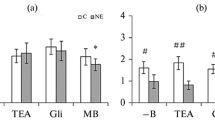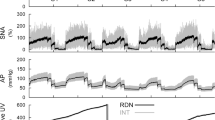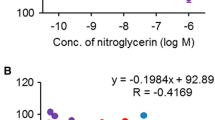Summary
The 5-HT-2 antagonist ketanserin (KAS) has been successfully used to treat acute hypertension in coronary bypass surgery. The present study was performed to investigate the effect of KAS on ischaemic myocardium. In 11 anaesthetized (piritramide) dogs, systolic contraction (sdL) and end-diastolic length (edL) of myocardium supplied by the left descending coronary artery (LAD) and the left circumflex coronary artery (LCX) were measured by sonomicrometry simultaneously with aortic pressure (AoP), left ventricular dP/dtmax and end-diastolic pressure (LVedP), heart rate (HR), stroke volume, and LAD flow (QLAD). Regional ischaemia to decrease sdLLAD (−48%) was achieved by LAD stenosis (QLAD −47%). Concomitantly, edLLAD increased by 8%. However, the other variables did not change. Then KAS was given i.v. (0.15+ 0.15+0.30+0.6mg/kg) at 15-min intervals. Following KAS, prestenotic sdLLAD recovered in a dose-dependent manner. LVedP and edLLAD decreased, sdLLCX increased, and the other variables were not affected. This functional recovery of ischaemic myocardium was attenuated by pretreatment with metoprolol (MET, 1 mg/kg) prior to LAD stenosis. The ischaemic area was not irreversibly damaged, however, as proven by the recovery of prestenotic sdLLAD values after release of the stenosis. The improved systolic shortening of ischaemic myocardium following KAS did not result from restored QLAD due to post-stenotic vasodilation or break up of platelet aggregates (QLAD did not increase) or from reduced afterload (AoP did not decrease). Obviously, it was mediated by β-1-receptors, as shown by the attenuation of the beneficial effect of KAS by pretreatment with MET.
Similar content being viewed by others
References
Ashton JH, Benedict CR, FitzGerald C, Raheja S, Taylor A, Campbell WB, Buja LM, Willerson JT (1986) Serotonin as a mediator of cyclic flow variations in stenosed canine coronary arteries. Circulation 73:572–578
Bolt GR, Saxena PR (1985) Cardiovascular profile and hypotensive mechanism of ketanserin in the rabbit. Hypertension 7:499–506
Brazenor RM, Angus JA (1982) Actions of serotonin antagonists on dog coronary artery. Eur J Pharmacol 81:569–576
Bush LR, Campbell WB, Kern K, Tilton GD, Apprill P, Ashton J, Schmitz J, Buja LM, Willerson JT (1984) The effects of alpha-2-adrenergic and serotonergic receptor antagonists on cyclic blood flow alterations in stenosed canine coronary arteries. Circ Res 55:642–652
Clerck FF de, David JL, Janssen PAJ (1982) Inhibition of 5-hydroxytryptamine-induced and-amplified human platelet aggregation by ketanserin (R41468), a selective 5-HT2-receptor antagonist. Agents Action 12:388–397
Davy M, Midol-Monnet M, Heimburger M, Beslot F, Cohen Y (1987) Peripheral and central cardiovascular effects of ketanserin in conscious normotensive rats. Arch Int Pharmacodyn Ther 290:193–206
Elfellah MS, Ogilvie RI (1985) Effect of vasodilator drugs on coronary occlusion and reperfusion arrhythmias in anesthetized dogs. J Cardiovasc Pharmacol 7:826–832
Furukawa Y, Saegusa K, Ogiwara Y, Chiba S (1986) Effects of ketanserin on the pacemaker activity and contractility in the isolated, blood-perfused dog atrium. J Cardiovasc Pharmacol 8:967–972
Gallagher KP, Osakada G, Kemper WS, Ross J (1986) Cyclic coronary flow reduction in conscious dogs equipped with ameroid constrictors to produce severe coronary narrowing. Basic Res Cardiol 80:100–106
Gradin K, Pettersson A, Hedner T, Persson B (1985) Antihypertensive effects of ketanserin in the spontaneously hypertensive rat: model of action. J Cardiovasc Pharmacol 7 [Suppl 7]:S110-S111
Gradin K, Pettersson A, Hedner T, Persson B (1989) Central sympathoinhibitory effect of ketanserin in the spontaneously hypertensive rat. Pharmacol Toxicol 64:352–355
Groß T, Lues I, Daut J (1992) The new cardiotonic agent EMD 57033 decreases energetic tension cost in isolated cardiac muscle. Pflugers Arch 420 [Suppl 1]:R91
Hagl S, Froer KL, Heimisch W, Braun E, Gebhardt K, Mendler N (1977) Der Einfluß von Nitraten auf die Funktion des ischämischen Myokards. Thoraxchirurgie 25:219–229
Hauss J, Schönleben K, Spiegel HU, van Aken H (1984) Effect of ketanserin on micro- and macrocirculation. Ketanserin Research News Janssen Research Foundation, Beerse
Heimisch W, Hagl S, Gebhardt K, Meisner H, Mendler N, Sebening F (1981) Direct measurement of cyclic changes in regional wall deometry in the left ventricle of the dog. Innov Tech Biol Med 2:487–501
Hodsman NB, Colvin JR, Kenny GN (1989) Effect of ketanserin on sodium nitroprusside requirements, arterial pressure control and heart rate following coronary artery bypass surgery. Br J Anaesth 62:527–531
Humphrey PPA, Fenjuk W, Watts AD (1983) Prejunctional effects of 5-hydroxytryptamine on noradrenergic nerves in the cardiovascular system. Fed Proc 42:218–222
Isoyama S, Maruyama Y, Ashikawa K, Sato S, Suzuki H, Watanabe J, Shimizu Y, Ino-Oka E, Takishima T (1983) Effects of afterload reduction on global left ventricular and regional myocardial functions in the isolated canine heart with stenosis of a coronary arterial branch. Circulation 67:139–147
Leysen JE, Awonters F, Kennis L, Laduron PM, Vanderberk J, Janssen PAJ (1981) Receptor binding profile of R41468, a novel antagonist at 5-HT-2 receptors. Life Sci 28:1015–1022
Liang IYS, Jones CE (1985) Alpha-1-adrenergic blockade increases coronary blood flow during coronary hypoperfusion. Am J Physiol 249:H1070-H1077
Malinovska B, Pietraszek M, Chabielska E, Buczko W (1989) The influence of propranolol on the hypotensive action of ketanserin in normotensive rats. Acta Physiol Pol 40:356–362
McCall R, Schuette M (1984) Evidence for an alpha-1 receptor-mediated central sympathoinhibitory action of ketanserin. J Pharmacol Exp Ther 228:704–710
Mollhoff T, van Aken H, Mulier JP, Muller E, Lauwers P (1990) Effects of urapidil, ketanserin and sodium nitroprusside on venous admixture and arterial oxygenation following coronary artery bypass grafting. Br J Anaesth 64:493–497
Nelson MA, Coghlan JP, Denton DA, Mills EH, Spence CD, Whitworth JA, Scoggins BA (1984) Demonstration of alpha-adrenoceptor antagonism by the 5-HT-2 antagonist ketanserin (R49945) in sheep. Clin Exp Pharmacol Physiol 11:597–604
Phillips CA, Mylecharane EJ, Shaw J (1985) Mechanisms involved in the vasodilator action of 5-hydroxytryptamine in the dog femoral arterial circulation in vivo. Eur J Pharmacol 113:325–334
Richter JA, Barankay A, Göb E, Späth P (1986) Cardiovascular effects of ketanserin in the treatment of hypertension during coronary artery bypass surgery. J Cardiovasc Pharmacol 8:109–115
Robertson JIS (1990) Recent insights into the antihypertensive mechanism of action of ketanserin. In: Paoletti R, Vanhoutte PM, Brunello N, Maggi FM (eds) Cardiovascular system, hypertension, and serotonin antagonists, Kluwer, Dordrecht, pp 113–121
Sachs L (1978) Angewandte Statistik, Springer, Berlin Heidelberg New York
Saman S, Thandroyen F, Opie LH (1985) Serotonin and the heart: effects of ketanserin on myocardial function, heart rate, and arrhythmias. J Cardiovasc Pharmacol 7 [Suppl 7]:S70-S75
Schad H, Heimisch W, Kalke Y, Mendler N (1988) Effect of heart rate changes by vagal stimulation on normally perfused and ischaemic myocardium in anaesthetized dogs. Pflugers Arch 411 [Suppl 1]:R34
Schad H, Heimisch W, Mendler N (1991) Models of coronary artery disease: “critical” versus “functional” coronary artery stenosis. Thorac Cardiovasc Surg 39:13–18
Schulz R, Miyazaki S, Miller M, Thaulow E, Heusch G, Ross J, Guth BD (1989) Consequences of regional inotropic stimulation of ischemic myocardium on regional myocardial blood flow and function in anesthetized swine. Circ Res 64:1116–1126
Seitelberger R, Guth BD, Heusch G, Lee JD, Katayama K, Ross J (1988) Intracoronary alpha-2-adrenergic receptor blockade attenuates ischemia in conscious dogs during exercise. Circ Res 62:436–442
Starre PJ van der, Harinck de Weerd JE, Reneman RS (1986) Nitroprusside and ketanserin in the treatment of postoperative hypertension following coronary artery bypass grafting: a haemodynamic and ventilatory comparison. J Hypertens 4 [Suppl]:S107-S110
Starre PJ van der, Reneman RS, Scheijgrond HW (1989) Ketanserin in the treatment of systemic hypertension during and following coronary artery bypass surgery. Angiology 40:1001–1010
Walker JM, Wilmshurst PT, Juul SM, Coltart DJ (1984) Acute effects of ketanserin on left ventricular function, metabolism and coronary blood flow. Br J Pharmacol 17:301–307
Water A van de, Wouters L, Xhonneux R, Reneman S (1985) Cardiovascular effects of ketanserin in closed-chest anesthetized dogs. Arch Int Pharmacodyn Ther 275:267–278
Woodman OL (1990) Enhanced coronary vasoconstrictor responses to 5-hydroxytryptamine in the presence of a coronary artery stenosis in anaesthetized dogs. Br J Pharmacol 100:153–157
Yoshioka M, Matsumoto M, Togashi H, Saito H (1987) Central sympathoinhibitory action of ketanserin in rats. J Pharmacol Exp Ther 243:1174–1178
Author information
Authors and Affiliations
Rights and permissions
About this article
Cite this article
Schad, H., Heimisch, W., Barankay, A. et al. Effects of the serotonin-antagonist ketanserin on the function of ischaemic and normally perfused myocardium and modification by β-1-blockade in anaesthetized normotensive dogs. Res. Exp. Med. 192, 355–365 (1992). https://doi.org/10.1007/BF02576292
Received:
Accepted:
Issue Date:
DOI: https://doi.org/10.1007/BF02576292




